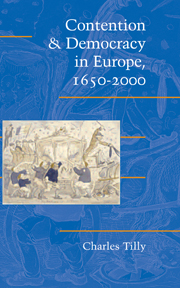2 - REGIMES AND THEIR CONTENTION
Published online by Cambridge University Press: 29 May 2010
Summary
Armed with our 21st-century democracy-finder, suppose we speed back to 17th-century Europe. In one part of Europe or another, we will find roughly 200 regimes we can reasonably call independent states: relatively autonomous, centralized, and well-bounded governments exercising priority in some regards over all other organizations operating within their territories. On four counters marked “Breadth,” “Equality,” “Consultation,” and “Protection,” we take readings for the regimes we locate in a journey throughout the continent. Where and when do we encounter vigorous vibrations of democracy?
Let's say we land in the year 1650. We might think it an auspicious year for democratic initiatives: except for continuing struggle between France and Spain the major disruptions of the Thirty Years' War have just ended with the Treaties of Westphalia, great fissures have opened in the Habsburg empire, and the success of their 16th-century rebellion against Spain has finally brought the northern Netherlands international recognition as a highly decentralized independent republic. What do we find?
We find plenty of revolution and war, but few signs of settled democracy. Touring the British Isles, we discover a Scotland rebelling openly against English hegemony, and a Scottish military force in northern England backing Charles Stuart's claim to succeed his father Charles I; just last year, England's contentious revolutionaries united temporarily to decapitate King Charles. In Ireland, Catholic leaders are battling not only each other, but also the English invading force of Oliver Cromwell.
- Type
- Chapter
- Information
- Contention and Democracy in Europe, 1650–2000 , pp. 42 - 69Publisher: Cambridge University PressPrint publication year: 2003

